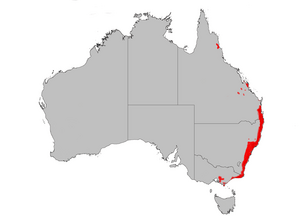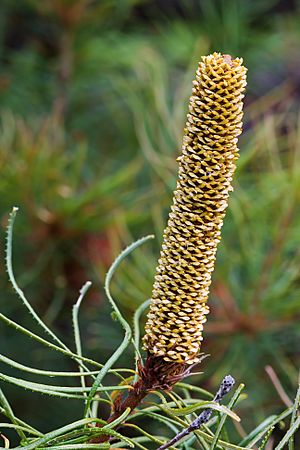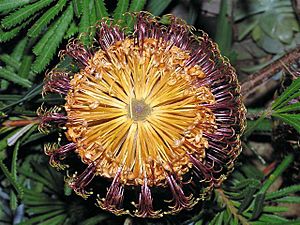Hairpin banksia facts for kids
Quick facts for kids Hairpin banksia |
|
|---|---|
 |
|
| Banksia spinulosa var. spinulosa, Georges River National Park |
|
| Scientific classification | |
| Kingdom: | |
| (unranked): | |
| (unranked): | |
| Order: | |
| Family: | |
| Genus: | |
| Species: |
B. spinulosa
|
| Binomial name | |
| Banksia spinulosa Sm.
|
|
| Varieties | |
|
|
The hairpin banksia (Banksia spinulosa) is a cool woody shrub that grows in eastern Australia. It's part of the Banksia plant family. You can find it growing in open dry forests or heathlands from Victoria all the way up to northern Queensland. It usually grows in sandy soil, but sometimes in clay too.
This plant is often a small shrub, about 2 meters (6.5 feet) tall. But it can also grow into a tall, thin tree up to 6 meters (20 feet) high! It has long, thin leaves and its flowers are very colorful. The main flower spikes are usually gold or yellow. But the tiny parts that stick out from the flowers, called styles, can be many different colors like black, purple, red, orange, or yellow.
Banksia spinulosa was first named by James Edward Smith in England in 1793. It was collected by John White in 1792. White called it the "prickly-leaved banksia," but that name isn't used much anymore. There are four main types, or varieties, of this plant. Scientists are still studying them to understand how they are all related.
The hairpin banksia is very important for animals. Many different vertebrate (animals with backbones) and invertebrate (animals without backbones) creatures visit its flowers. They help to pollinate the plant and also find food there, especially in autumn and winter. Because it's so pretty and has nice leaves, it's a popular plant for gardens. There are even special small types of hairpin banksia that are perfect for smaller gardens. One very popular type is called Banksia 'Birthday Candles'.
Contents
What the Hairpin Banksia Looks Like
The hairpin banksia is usually a shrub with many stems. It grows about 1 to 3 meters (3 to 10 feet) tall and 1 to 2 meters (3 to 6.5 feet) wide. It has a special underground part called a lignotuber. This helps it regrow after a fire. Sometimes, it can grow as a single-stemmed plant without a lignotuber. These can be taller, up to 5 meters (16 feet) high.
Its bark is smooth and grey or grey-brown. The leaves are long and thin, about 3 to 10 centimeters (1 to 4 inches) long and 1 to 8 millimeters wide. They are usually straight and narrow. The edges of the leaves can be saw-like (serrated) along their whole length or just near the tip. Young leaves, or those that grow after a bushfire, are wider and more serrated. The underside of the leaves usually has fine white or pale brown hairs.
Flower Spikes and Styles
The unique flower spikes, also called inflorescences, bloom in autumn and early winter. Each spike has hundreds or even thousands of tiny flowers. Each small flower has a tube-like part called a perianth and a long, thin part called a style. The styles are hooked, which is a special feature of this plant group.
When the flowers open, the styles break free from the perianth. The spikes are shaped like cylinders, about 6 to 7 centimeters (2 to 3 inches) wide and 6 to 15 centimeters (2 to 6 inches) tall. They are yellow to golden orange. The styles can be yellow, pink, maroon, or even black. You might see different colored styles growing close together in some areas. The flower spikes grow from older stems and are easy to spot, poking out from the leaves.
Seed Cones
After flowering, the hairpin banksia forms a cone-like structure. This is called an infructescence. It holds up to 100 seeds in small pods called follicles. These pods are about 1 to 2.4 centimeters (0.4 to 1 inch) wide. They usually stay closed until a bushfire heats them up and makes them open.
The types of banksia that have a lignotuber can regrow from buds at their base after a fire. But the type without a lignotuber (var. cunninghamii) is killed by fire and grows back from its seeds. Old flower spikes turn brown, then grey. The old flower parts often stay on the cone for a long time, making it look hairy. However, in some parts of Queensland, the old cones are bare.
How Hairpin Banksia Was Discovered and Named
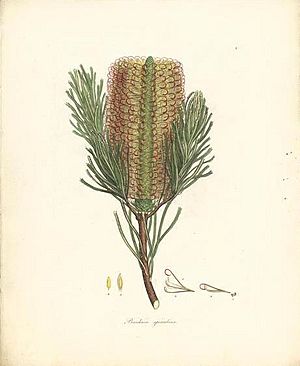
The first known hairpin banksia plants were collected near Sydney by John White. He was a surgeon for the British colony of New South Wales. This happened sometime between 1788 and 1793. White called it the "prickly-leaved banksia."
It's not certain exactly when he first found it. There's a drawing in his 1790 book, Journal of a Voyage to New South Wales, that might be of a hairpin banksia cone. The book said this plant seemed new and unnamed.
Later, in 1793, an English botanist named James Edward Smith officially described the species. He named it Banksia spinulosa. The word spinulosa is Latin for "having tiny spines." This probably refers to the tips of the leaves. So, the full scientific name is Banksia spinulosa Sm. This was the seventh Banksia species ever collected and the fifth one to be officially named.
Different Types of Hairpin Banksia
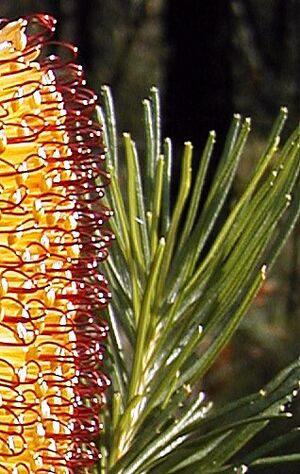
There are four main types, or varieties, of hairpin banksia that scientists recognize today:
- B. spinulosa var. spinulosa: This is the original type of hairpin banksia. It grows along the coast in Queensland and then again in New South Wales, south of Sydney, and into Victoria. Its flower spikes are often gold with black, maroon, or red styles. But sometimes they are all gold. Its leaves are usually narrow, about 1–2 mm wide, with only a few saw-like edges near the tip.
- B. spinulosa var. collina: This type is known as the hill banksia. It was first named as a separate species in 1810. But in 1981, scientists decided it was a variety of B. spinulosa. It has wider leaves (3–8 mm wide) with saw-like edges along the whole leaf. Its flower spikes are usually gold, sometimes with red styles. You can find it in inland areas of Queensland and along the coast in New South Wales.

- B. spinulosa var. cunninghamii: This variety was named in 1827 after botanist Allan Cunningham. It was also made a variety of B. spinulosa in 1981. However, some scientists still think it should be its own species. This plant is a fast-growing shrub or small tree, up to 6 meters (20 feet) tall. It grows in the Great Dividing Range from Queensland to Victoria. Its young leaves are very serrated, and new branches are hairy. The flower spikes are gold with black styles, though some all-yellow ones are found in Victoria.
- B. spinulosa var. neoanglica: This type is called the New England banksia. It was named by Alex George in 1988. It's a short shrub, usually less than 1 meter (3 feet) tall, with a lignotuber. It grows in the New England area of northern New South Wales and southeastern Queensland. Its flowers are gold with black styles.
Scientists are still studying these varieties to understand their relationships better.
Natural Hybrids
Sometimes, different types of banksias can mix together naturally. This creates a natural hybrid. For example, natural hybrids between B. spinulosa var. spinulosa and B. ericifolia have been found. Also, a garden plant called Banksia "Giant Candles" was created by accident when B. ericifolia and B. spinulosa var. cunninghamii crossed.
Where Hairpin Banksia Grows
The hairpin banksia grows along the east coast of Australia. You can find it from the Dandenong Ranges near Melbourne, Victoria, all the way north through New South Wales and into Queensland. It's very common up to Maryborough. You can also find smaller, separate groups of them much further north, near Cairns.
It lives in many different places. Some grow in coastal heathlands, while others are on high, rocky slopes. It also grows in dry sclerophyll forests, which are forests mainly made up of eucalypt trees. Here, they grow as smaller plants under the taller trees. Plants in windy, open areas are usually shorter than those in sheltered spots. It mostly grows in sand, but can also be found in rocky clay or loamy soils.
How Hairpin Banksia Lives (Ecology)
Like other banksias, the hairpin banksia is a home for many different animals. It's a very important source of nectar (a sweet liquid) in autumn and winter when other flowers are scarce. Many studies have looked at how banksias are pollinated.
A study in 1998 found that small mammals, like the marsupial called the Yellow-footed antechinus, visit B. spinulosa flowers. These animals carry a lot of pollen, making them good pollinators. The study also noticed that native bees visited this banksia more often than the introduced European honey bee.
Many bird species also visit the hairpin banksia. Birds like the Eastern spinebill, White-eared honeyeater, and Yellow-tufted honeyeater feed on its nectar. Small mammals like pygmy possums, sugar gliders, and bush rats also visit the flowers.
Special Roots
Like most plants in the Proteaceae family, B. spinulosa has special roots called proteoid roots. These roots have dense clusters of short side roots that form a mat just under the leaves on the ground. These special roots help the plant take in nutrients from poor soils, especially soils that don't have much phosphorus. This is common in Australia's native soils.
Conservation Status
The hairpin banksia is not currently in danger. It can resist a plant disease called Phytophthora cinnamomi dieback, which harms many other Banksia species. Also, because it grows in so many different places, it's protected from losing its habitat due to land clearing. So, it's not on the list of threatened plants in Australia.
Growing Hairpin Banksia in Your Garden (Cultivation)
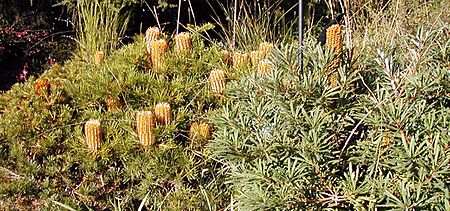
The hairpin banksia was first grown in gardens in the United Kingdom in 1788. It's a beautiful plant that attracts birds. Plants from southern or mountain areas can handle frost. Generally, all types of hairpin banksia like sandy, well-drained soils and sunny spots. It can resist dieback disease, like most banksias from eastern Australia.
However, Banksia spinulosa doesn't like soils with high pH (alkaline soils). This can cause iron deficiency, where new leaves turn yellow but the veins stay green. This can happen if the soil has cement in it. You can treat this with special iron products.
It's good to prune your hairpin banksia regularly. This helps it grow into a nice shape and stops it from becoming too leggy (long and thin). Most garden types of this plant have a lignotuber, so they can grow back even if you prune them very hard, almost to the ground. But the var. cunninghamii type does not have a lignotuber, so you shouldn't prune it below its leaves.
It can take up to eight years for a hairpin banksia to flower from a seed. You can get flowers faster by buying a plant that's already grown a bit, or one grown from a cutting. Hairpin banksia is fairly easy to grow from seeds or cuttings. Special named types, called cultivars, must be grown from cuttings to make sure they are exactly like the original plant.
You can often find B. s. var. collina and var. spinulosa at plant nurseries. If you live near a natural bushland area, it's best to find plants from a local nursery or group. This helps protect the native plants in the wild.
Popular Garden Types (Cultivars)
There are several popular types of hairpin banksia that you can buy for your garden. Many of these are smaller, dwarf forms, perfect for modern gardens.
- B. s. var. collina 'Carnarvon Gold' is an all-gold flowered type from Queensland. It grows to about 2–5 meters (6.5–16 feet) tall and 2–4 meters (6.5–13 feet) wide.
- B. s. var. collina 'Stumpy Gold' is a spreading type, about 40 cm (16 inches) high and up to 1.2 meters (4 feet) wide. It has light gold flowers and comes from New South Wales.
- B. s. var. spinulosa 'Birthday Candles' is a very popular compact plant. It grows to about 45 cm (18 inches) tall and up to 1 meter (3 feet) wide. It has gold flowers with red styles. This type was found near Ulladulla in New South Wales.
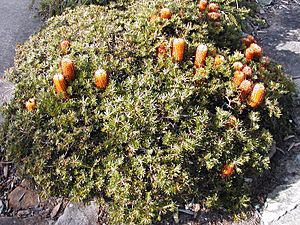
- B. s. var. spinulosa 'Cherry Candles' was created from 'Birthday Candles'. It's also compact, about 45 cm (18 inches) tall, with cherry-red styled gold flowers.
- B. s. var. spinulosa 'Coastal Cushion' is a more spreading plant, up to 50 cm (20 inches) tall and 1.5–2 meters (5–6.5 feet) wide. It has dark red-styled gold flowers and grows well in southeastern Queensland.
- B. s. var. spinulosa 'Golden Cascade' is another spreading type, about 30 cm (12 inches) tall and 1.5–2 meters (5–6.5 feet) wide. It has red-styled gold flowers.
- B. s. var. spinulosa 'Honey Pots' has all-gold flowers and can grow up to 1 meter (3 feet) tall and 1.2 meters (4 feet) wide. It comes from Victoria.

- B. s. var. cunninghamii 'Lemon Glow' was named in 1982. It grows 2–3 meters (6.5–10 feet) tall with all lemon-yellow flowers. It can handle frost and some dry periods.



